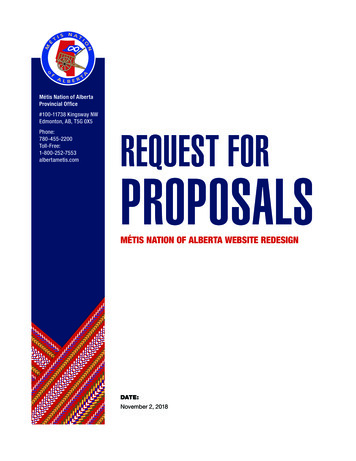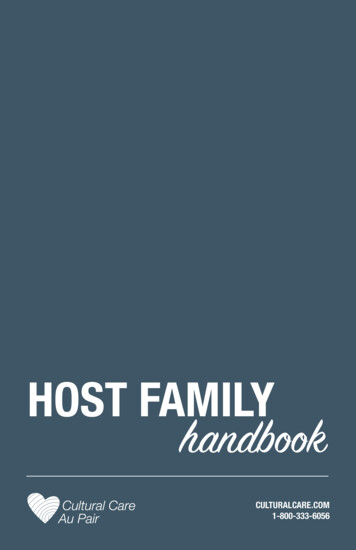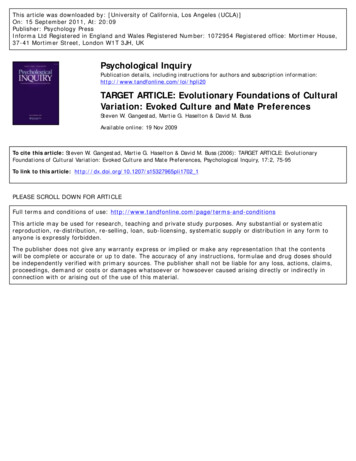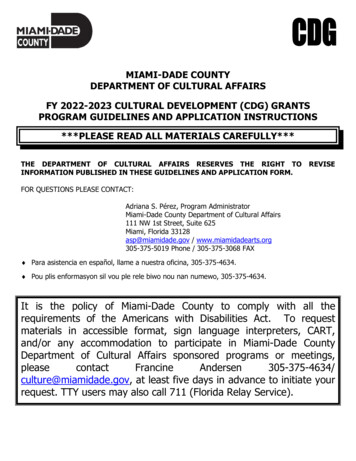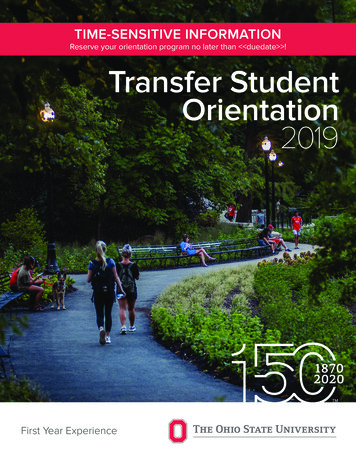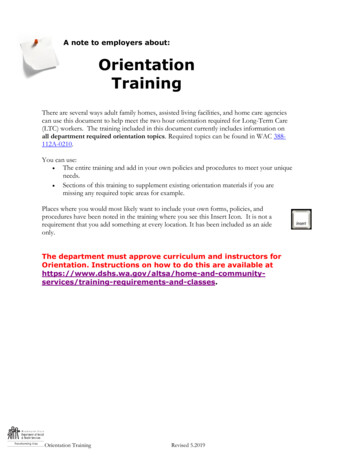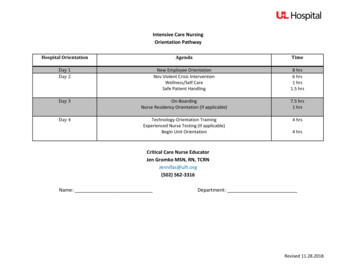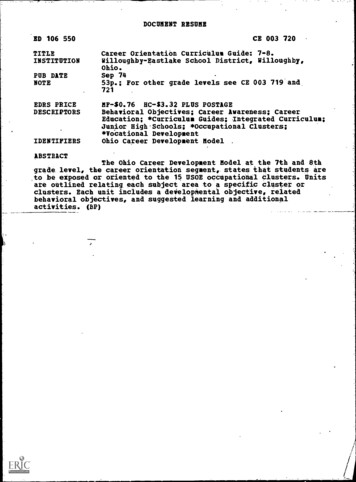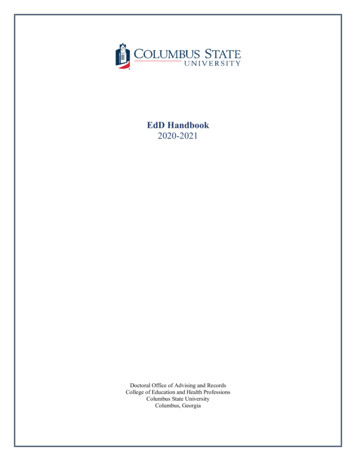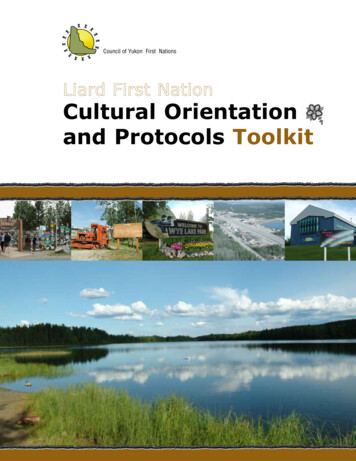
Transcription
Council of Yukon First NationsLiard First NationCultural Orientationand Protocols Toolkit
TABLE OF CONTENTS1.0H ISTORY. 12.0CURRENT S TATUS IN LAND CLAIMS, S ELF G OVERNMENT OR O THER . 43.0COMMUNICATION AND R ELATIONSHIPS . 74.0S PECIFIC CULTURAL V ALUES AND B ELIEFS . 75.0B IRTH, D EATH AND P ARENTING . 86.0P OTLATCH T RADITIONS & N AMING . 87.0M ARRIAGE . 98.0T RADITIONAL LAWS . 99.0T RADITIONAL H EALTH AND H EALING . 1010.0P ROTOCOLS . 1110.1Approaching Elders for advice or teachings . 1110.2Accessing and sharing traditional knowledge . 1110.3Home visiting & invitations . 1210.4Speaking/meeting to individuals of the other gender . 1210.5Dealing with conflict and confrontation . 1310.6Prayer, Language and Meetings . 1311.0Community People, Health and Social Well- being . 1411.1Population and Demographics. 1411.2Education . 1411.3Health and Social Strengths . 1411.4Community Challenges and Issues . 1411.5Community Uniqueness and Spirit. 1512.0COMMUNITY H EALTH & S OCIAL S ERVICES S TAFF . 15BIBLIOGRAPHY . 16
Photo onds,fonds,fonds,fonds,fonds,Jocylyn McDowellGladys NetroLouise ParkerRandy TaylorYukon Government Collection#7283#8196#8432#8236#8242#7114
LIARD FIRST NATION SPECIFIC CULTURALORIENTATION AND PROTOCOLS1.0HistoryFor tens of thousands of years, Kaska Dena have lived in over 240,000 squarekilometres of land in the southeast Yukon, southern Northwest Territories, andnorth-western British Columbia. With the establishment of provincial and territorialborders the Kaska nation was separated into five Kaska families which through theIndian Act were called First Nations.In the Yukon, there are two Kaska First Nations – Liard First Nation and Ross RiverDena Council who live primarily in the communities of Ross River, Upper Liard,Lower Post and Watson Lake. In B.C. there is the Dease River First Nation at GoodHope Lake, the Lower Post First Nation near Watson Lake and the Kwadacha FirstNation at Fort Ware, NWT.The traditional territory of the Kaska includes the upper Liard, Frances and HylandRivers and extends into the upper Pelly drainage in the north and to the DeaseRiver in the southwest.The Liard First Nation people spokeKaska an Athabaskan language whichis spread over western Canada,Alaska and southeastern US. Theindigenous name is dene dzage “thepeople’s language”. Kaska is closelyrelated to neighbouring languagessuch as Talhtan, Sekani, Beaver,Slavey, Southern Tutchone andNorthern Tutchone. The dialects ofKaska spoken in different regionsdiffer somewhat in the pronunciationof words and in the terms that areused for certain expressions. Thelanguage is no longer in everydayuse, however Elders and those whodo traditional work on the land stillspeak Kaska, mostly among friendsand family.(Source: Kaska Dena Council website)1
Pre contact LifestylesThe Kaska were the original people of the area. They were seasonal migrants whotravelled within their established territory while hunting and gathering food. Theyfollowed the birds, animals and fish according to migration patterns and seasonalcycles.Historically Kaska traded and inter-married with both Tlingit and Tahltan tradingpartners. The ancestors of contemporary Kaska were already using guns and steeltools supplied by Tlingit traders when Robert Campbell and other white tradersarrived. In the later fur trade period the Kaska in the Liard drainage, also interactedextensively with Slavey people of the lower Liard and Nelson Rivers. Active trailswere maintained between what is now Watson Lake and the territory of the Tlingitpeople to the north. The Davie Trail linked the Kaska of southern Yukon with andother Kaska people in what is now Ross River and on up to Fort Norman in theNorthwest Territories. Packs were used on dogs and even children carried smallpacks during long walking journeys. Dogs were decorated with beautifully beadedharnesses for packs in the summer and dog teams in the winter.Pre contact lifestyles revolved around survival and self-sufficiency – depending onthe land for food and shelter. Skills in bush survival, building snowshoes, drummaking, trapping, hunting, fishing and gathering were highly prized. Preparingmoose hides for use in making clothing and other important items was also animportant skill. The natural plants of the land offered many important medicinesand individuals learned how to use the “medicine from the bush” from their parentsand grandparents.Elders were highly respected for their life time of accumulated knowledge and werehonoured as important role models and teachers. The “Kaska calendar” was used aspart of oral tradition to mark the seasonal patterns and passage of time. Traditionallaws called “A’I” guided behaviour and defined relationships with a view topreventing conflict and managing peace within the nation. The strict laws includedharsh punishment for anyone who abused a woman or a child. Traditional valuesand beliefs were the foundation of family and community life. Traditions werepassed on through stories. As an Elder stated, “there was a story to go witheverything.” The Elder went on to say “there was no life like our life – we hadnothing and we had everything. There was the richness of our culture, our health, acaring community and love”. “Everyone was responsible for everyone else”.Rites of passage were used to celebrate when a girl became a woman and a boybecame a man. Women were seen as the “givers of life” and greatly respected.Women were often recognized as leaders. Even in situations where men made thedecisions, “behind the men were the women”. Hospitality, generosity and respectwere very important values. When visitors came, the practice was to “open thedoor, feed them, and give them a place to rest”. Everything in the living world wasseen to have been created as equal – the animals were thought of as once humanin another life and the water and the land were seen to be alive and respected asequal to humans. In was not uncommon for people to communicate with animals.2
The land was not to be feared – “they know you (the spirits of the land) and respectyou”.Impacts of Early Exploration and TradeAs European explorers crossed the eastern mountains into Kaska lands, tradebetween them quickly developed. In the 1800s trading posts were establishedwhich altered the migration patterns of the Kaska people as they began to settlenear the posts.Gold RushThe Klondike gold rush had limited affect on the Kaska. The main transportationroutes of the gold seekers were miles away from Kaska territory. Where they feltimpact was on trade related relationships with neighbouring First Nations.The Dease Lake gold rush in 1861 and the Cassiar gold rush in 1874 were felt bymore Kaska people. The influx of people had more of an affect as some of the goldseekers stayed. It was the “toe in the door” so to speak.Residential SchoolsLike other First Nations, the Kaska were deeply affected by residential school. Therewas a residential school at Lower Post, the Kaska community just south of theYukon – B.C. border, 17 miles south of Watson Lake and the home of the Liard FirstNation. Many of the stories of the experience of Kaska people in Lower Post andother residential schools have just begun to surface in the last 5 to 10 years.The First Nation has been actively addressing the impacts of residential school onthe citizens of LFN for many years. In 1999, the Liard Aboriginal Women’s Society(LAWS) was established “to implement a comprehensive healing strategy toaddress the physical and sexual abuse of the residential schools.”(www.liardaboriginalwomen.ca). Since that time, LAWS has designed and managedmany projects to assist people in healing from the legacy of the residential schoolexperience. The most recent contribution to the community is a 10 Year Plan toaddress addictions which was released in April 2010. Unfortunately, the primarysource of funding for LAWS has been the Aboriginal Healing Foundation and thatfunding source has ended effective March 31, 2010.Kaska children were steeped in their language, traditions and culture prior to beingforcibly removed to the residential school. Kaska spirituality was embedded into theway the children interacted with each other and the natural world. They had beentaught to be caring people who are helpful to others and deeply respectful of all ofCreation. Once at the schools, children were told that they were pagans and thatthey must embrace the whiteman’s religion if they were to be saved. They wereseen and treated as “savages” who needed to be civilized.3
Alaska HighwayWhen the Alaska Highway was pushed through pristine wilderness and into theYukon, the area around Watson Lake was the first to be impacted. The time wasearly WW II 1942 to be exact and the highway was built in nine months. It was anaggressive, military “invasion” for the purposes and securing Alaska and all of itsresources from threats around the Pacific Rim during the war. The American armybuilt the road and as most of the workers were men, the presence of so many menfrom outside the community impacted both men and women. Some Kaska werehired as guides to show planners the best routes and the wage economy wasintroduced to the Kaska. Today, there are still dump sites along the highway routethat are affecting some lakes.2.0Current Status in Land Claims, Self Government or OtherLiard First Nation is the largest of the four First Nations which represent the citizensof the Kaska Nation. Centered in Watson Lake, Yukon and Lower Post BritishColumbia, LFN is politically and legally responsible to represent the public interestconcerns of its citizens throughout Kaska traditional territory in Yukon, BritishColumbia and the Northwest Territory. These public interests are increasingly wide,complex and diverse in scope.Until the 1960's citizens of Liard First Nation governed themselves effectively undera complex, comprehensive and effective political, social and culturally foundedsystem of policy development and decision making. As the Elders say “why do wehave to worry about self government – we have always had self government andwhy does it need to be put on paper?”A unique cultural and spiritual world view and source of knowledge,contemporaneously known as Dena Keh, along with related laws, sometimesreferred to as Dena A’I Nezen, provided the philosophical, ideological and moralfoundation for all decisions. These unique culturally and spiritually founded systemsevolved over thousands of years and were tested and proven effective throughoutprofound transformative events; climate change, wars, economic upheavals andepidemics of disease, for example.As part of the evolving colonial assimilationist policies of the Government ofCanada, all Yukon First Nations began to experience the application of the IndianAct sometime in the late 1950's, early 1960's. Along with other Yukon FirstNations, Liard First Nation saw the sudden imposition of a new social and politicalorder; an Indian Act Band Council, forced removal of children to residential schoolsand the relocation of entire communities to locations in closer proximity to thosechildren to note a few.Simultaneously, in the early 1960's, Liard First Nation began to receive the firstprograms and services presented by the federal Department of Indian and NorthernAffairs. These services were largely limited to a social welfare system and socialhousing as part of a national program applicable to “Indians” across Canada.4
The sociological, political and cultural affects of these colonial policies andlegislation, applied simultaneously, were and are profound. As the colonial policiesintended until quite recently, a breakdown of Kaska social, political, cultural andeconomic structure and efficacy began to take place within one generation. By theearly 1980's, those Kaska families who personally survived their residential schoolexperiences and relocations from traditional villages and their associated economiesbegan to feel the effects of assimilationist policies.A society that was largely economically and otherwise self sufficient, healthy andprosperous began to become reliant upon welfare for an income and social services,including social housing, to meet their needs. By the second generation followingthe application of federal assimilationist policies, increasing numbers of Kaskafamilies were becoming dependent on social welfare systems instead of theirproven methods of self sufficiency. The impacts on family and individual health andwell being, cultural continuity and economic and general self sufficiency were, andcontinue to be profound and pervasive.Concurrent with the increasingly negative effects of these colonialist policies, ahealthy and positive resistance to these assimilationist policies began among Kaskaand other First Nation people across Canada. Empowered by historically importantSupreme Court of Canada decisions in the 1970's and 1980's (ie. Calder andSparrow), and effective political action (ie. White Paper and Berger Inquiry), LiardFirst Nation took its place among other First Nations in asserting its just and rightfulplace in Canadian society and political structure.Many individual Kaska citizens and families found sobriety, and with it a culturallycompetent and consistent way forward into what had become a profoundly differentnew world order. Acting in concert, LFN citizens reformed the Indian Act politicalsystem that was imposed by the Government of Canada, an evolution thatcontinues to this day.Over the last twenty-five years, the contemporary LFN government has assembleda public administration from a wide spectrum of government sponsored programsand services. While its evolution has been ad hoc and opportunistic, today's LFNpublic administration offers a remarkable range of services to LFN citizens deliveredin ways that demonstrate considerable competence and accountability. Thisconsiderable success as a rapidly developed public government is a testament tothe persistence and commitment of LFN citizens, public officials and leadership.Today, Liard First Nation employs over 100 people. It offers a complex range ofpublic services that have an annual value of approximately ten million dollars. LFNis a known political force to be reckoned with throughout its traditional territory inYukon, British Columbia and the Northwest Territorities. Its’ corporations aresound, and has assets in the millions of dollars, with annual revenues to match.Significantly, LFN's cultural competence and probabilities for sustaining culturalcontinuity rise as increasing numbers of Kaska families and individuals findapplications for Kaska culture in contemporary political, economic and socialdevelopment.5
It is this success that may present LFN's greatest challenge in the future.The trajectory for required public service is increasing steeply in proportion to thepolitical responsibilities required of the LFN government and the program andservice needs expressed by its citizens. Public revenues are likely to increaseexponentially with the continued increase in political and economic success nowunderway. The ability to effectively and competently manage the relatedadministrative responsibilities and accountabilities will become challenged.LFN's current capacity to effectively manage its financial and human resources iscompetent. It is also taxed to the maximum. While frequently challenging, LFN'scurrent public administration, particularly its finance and senior managers, theDirectors, can handle the demands placed upon it today. Today's LFN publicadministration will not be able to meet the challenges it is presented with as aresult of the success and growth that now appears inevitable, unless these newdemands are systematically considered, planned and made manifest.Change requiring management can be the result of many things. Sometimes it is aresult of economic collapse, climate or ecological devastation, war, famine, diseaseor other catastrophic events. All of these catastrophic events have taken place overthe course of Kaska people's existence. All have required systematic change in thepast, without which Kaska people would not have survived, let alone prospered.Kaska society is one of the oldest societies in continuous existence in NorthAmerica. The single most important reason for this resilience is arguably Kaskapeople's ability to adapt to change.Today, LFN is in the enviable position of requiring managed change due to itscontinued success as a people and a government. This project is intended to form apart of that systematic consideration, planning and effecting of change; adaptation.This is no different from what the ancestors have done so well before.(Author for the above portion of section 2.0 –Tom Cove, LFN Government Advisor)The Liard First Nation and Ross River Dena Council have not entered into a MOU toconclude their land claims and remain under the federal Indian Act. The Kaska landclaims are part of the first comprehensive claim accepted by Canada under its 1973policy. The claims were accepted by the federal government in 1973 in the Yukon,and in 1983 in B.C.In addition, agreements related to energy and mineral development, forestry andtourism have been signed between the Kaska, Canada, and British Columbia. Theseagreements provide opportunities for the Kaska to participate in resourcemanagement and benefit from resource-related development on the Kaskatraditional territory while treaty negotiations continue. These agreements will createthe momentum for growth and development in Kaska communities.6
LFN Governance and StructureThe Liard First Nation is represented by an elected chief and a four person council.A tribal chief presides over the Kaska Tribal Council, which includes three bandgovernments (Liard First Nation, Ross River Dena Council, Dease River First Nationin BC).The structure of the LFN government includes the following departments:Health & SocialJusticeLands & ResourcesLanguage & ion and RelationshipsThe deep connection to the land is vital. The authority and identity of the Kaskapeople comes from and is tied to the land. It is the land that provides a deep senseof place and sense of self. The relationship exists at both the physical and thespiritual level. This relationship gives purpose to the people – to protect the land,which in turn ensures the well-being of the people.In a small community, relationships are close and everyone knows one another.This means the community is able to come together in times of need and worktoward the common good. It also can mean personal disagreements or conflictsare felt on my levels in the community. Being aware the family networks anddynamics is critical.4.0Specific Cultural Values and BeliefsCultural practices continue to play an important role in the lives of the Kaskapeople. Fishing, hunting, trapping and gathering berries and medicinal plants areimportant cultural activities. They provide not only healthy food, medicines andvaluable resource materials for the community members, but also connect thepeople to the land, to their history, and through the sharing of such bounties, toeach other. Sharing is an important dimension of First Nations harvesting; food isprovided not only for one’s immediate and extended family, but also for Elders ofthe community.Modesty was highly valued and once traditional skin clothing was traded in forclothing made of cloth, Kaska women wore long dresses, even when on the land.Women and men were expected to dress in a way as to not show their body. Shortswere only worn by children. Pants were not adopted by Kaska women until the1950’s and even then, it was rare to see a woman in pants.7
Taboos were in place about when and where animals could be skinned and therewere specific skins that were not used for sewing. One such skin was otter skinwhich was not to be used for clothing. Animal skin is understood to be “strongmedicine” and the rules about how the skins are to be respected must be obeyed ornegative events could take place.5.0Birth, Death and ParentingPregnant women were provided traditional teachings to support a healthypregnancy. One such teaching is that she should not sit on a bear skin for too longfor fear that the baby will “hibernate” therefore prolong the pregnancy. Pregnantwomen were advised not to go to funerals. Ashes were used as protection againstroaming spirits for individuals and homes.Births were celebrated and deaths were honoured through potlatch traditions.Parenting, the role of guiding a child into responsible adulthood through teaching ofvalues, most importantly respect, was seen as the most important role for allcommunity members and particularly the parents, aunts, uncles and grandparentsof the child. This most important purpose of family and community was brokendown when children were removed from homes and forced into residential schools.A “living will” was used by the Dene to make arrangements for continuity of thefamily in the event of a death. A woman might arrange with her sister and a manwith his brother to take on responsibilities as parent and spouse in the event of adeath.Traditional funerals and potlatches have strict codes. When a clan member dies, theopposite clan dresses the body and arranges the funeral, burial and potlatches. Onemust wait for one week after the burial before you cut your hair or even nails.Charcoal or ashes are put in the pocket, under the pillow or around the house tokeep family members safe when they sleep. One week is waited between the deathand the burial and a wake is held if possible. Family members often bring food tothe grieving family. At the funeral, no one leaves until the coffin has left thebuilding. At the Potlatch, before anyone can eat it is tradition to offer food to thespirit first – this is done by offering food to the main fire which is made specificallyfor this purpose. Tobacco may be offered as well.6.0Potlatch Traditions & NamingPotlatches were used to celebrate marriages and special events. In addition, theywere used to mark the passing of a person near the time of the death – the funeralpotlatch and again a year or so after the death. Traditionally, the potlatch one yearafter the death was to mark the end of the acute grieving period and also to giveaway items belonging to the deceased.Another reason for a potlatch is a naming ceremony. Names are given at anytimethroughout life from baby still in the womb to an older person that may bereceiving a first name, a new name or an additional name. Tradition states that it8
has to be the right name at the right time. Names may be passed along withinmembers of a family or community. It is a high honour to be given a traditionalname.Part of the potlatch tradition is the “give away” where gifts are offered. It isimportant to accept any gift that is offered. It is seen as disrespectful to say “no”. Itis important to accept a gift offered graciously. Giving and receiving are deeply heldvalues that are honoured in the potlatch tradition.The serving of food is part of the potlatch traditional and it important to not wastefood given on a plate and also to help make sure no food is wasted by taking homefood not eaten during the gathering.Current day potlatch organizers ask people to bring their “potlatch bag” with aplate, cup and eating utensils to reduce the use of disposable materials. Somepeople have decorated potlatch bags that have gone along with them to manygatherings. Today, potlatches are smaller than they were traditionally and may beheld in a variety of ways, depending on the family. The last big traditional potlatchthat can be remembered was about 20-30 years ago.7.0MarriagePrior to contact, marriages were arranged. The families of the two individuals wouldconsult with one another and make decisions on behalf of the people to be married.Even though the marriages were arranged, it was not unusual to have longcourtships through which the man was expected to prove to his future in-laws thathe could support his intended wife. Part of the courtship was hunting and trappingfor the grandparents of his wife to be. Traditionally, the woman did not leave herfamily. It was the man who joined the woman’s family.8.0Traditional LawsTraditional laws were mostly structured around “you are not allowed to”. Certainactions were prohibited and the Elders were responsible for teaching what can andcannot be done. One look or word from an Elder was seen as enough to cause acorrection in behaviour. It was seen as disrespectful to question an Elder or anolder relative and communication was often carried out without eye contact, as asign of respect.If traditional laws were broken, the clan that was shamed by the action of the guiltyparty was expected to pay reparation to the clan that had been offended. The Wolfand Crow clans are in place as part of the Kaska culture, similar to other YukonFirst Nations with the exception of the Tlingit. The Kaska clans are matrilineal withthe child taking on the clan of the mother.Land is seen as sacred and the Kaska have been given the honour of stewardship oftheir traditional lands by the Creator. The lands are not seen to be “owned” by theKaska, but they take their sacred responsibility for the land very seriously. There9
are a number of traditional laws around how the land and all things from nature areto be respected and treated. One warning that is embedded in the laws is that if theland and its richness are not respected, people will become poor, hungry, disabledor simple minded. Disrespect is expected to be punished by the effects coming“back to you or it will come back to your family or loved ones.” The general rule isthat “if you cannot survive by it, leave it alone. Use everything from animal orplants, waste nothing.” It is also expected that everything that comes off the landwill be shared.The Dene Maintenance Code is in place to enforce the Dene values and to ensurethese values are maintained from generation to generation. The Dene codesexpress the grandparent’s rights and are handed down from generation togeneration through stories and legends, Elders, leadership, songs, family names,clans, dances and teachings. These maintenance codes are intended to provide forthe affairs of the clans, in a manner that carries out the customary codes whilemaintaining Dene government, including rights, title and other interests.The Dene Society Code supports the matrilineal society and identifies the affiliationof family members, connection to family use areas on the land, hunting, fishing andgathering rights and the Dene Clan code. The Dene Clan Code describes the CrowClan and the Wolf Clan and describes the “blood” relationship within clans.Everything is connected to these two clans of life.Self–control and Self Discipline Codes are taught to children from their earliestyears by people older than them. The Education Code was strong in that trainingneeded to be intense to ensure survival from generation to generation. Learningwas shared collectively and for both men and women, in different ways. It was upto the older ones to teach hunting, trapping, gathering and fishing. The teachingscome in many forms – stories and legends, songs and dances, Elders teachings,show and tell (demonstrations) and passed on at Clan gatherings and celebrations.The Dene Social Calendar Code showed that the year has thirteen months as it hasthirteen new moons. The Dene were taught to understand the calendar by learningto read the natural environment, the animal’s life cycle and the Dene’s natural diet.They would use the calendar to tell them when to gather for special ceremonies,when to hunt, when to fish, when to harvest and when to trap. These routines kepteverything in balance. This in known as the “keep going cycle”, that is taught to theDene throughout various life stages. There also were Codes for men and women tosupport coming of age and understanding traditional gender roles and relationships.9.0Traditional Health and HealingStories were used for many purposes and some for the purpose of supportinghealth and healing. Not hearing the stories and not taking time to listen and
Nation. Many of the stories of the experience of Kaska people in Lower Post and other residential schools have just begun to surface in the last 5 to 10 years. The First Nation has been actively addressing the impacts of residential school on the citizens of LFN for
